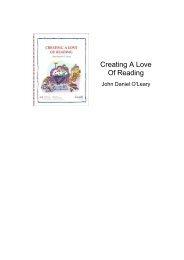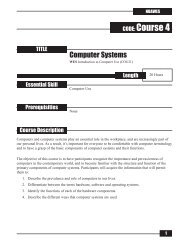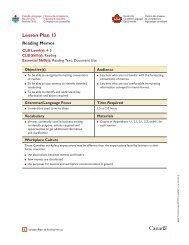Integrating Essential Skills into Training - National Adult Literacy ...
Integrating Essential Skills into Training - National Adult Literacy ...
Integrating Essential Skills into Training - National Adult Literacy ...
Create successful ePaper yourself
Turn your PDF publications into a flip-book with our unique Google optimized e-Paper software.
The demands of oral communication are dependent upon:<br />
◊ why one is communicating<br />
◊ how one is communicating<br />
◊ the range and complexity of the information being conveyed<br />
◊ the circumstances in which one is communicating<br />
◊ the person with whom one is interacting<br />
◊ the seriousness of the consequences if communication fails<br />
Problem Solving<br />
Problem solving refers to the addressing of problems that require solutions – the knowledge<br />
and skills required in elaborating projects, identifying relevant information in order to plan and<br />
analyze. For the worker, a problem is a situation or occurrence that interferes with the<br />
accomplishment of job tasks. Although the problem is always seen from the worker’s point of<br />
view, it is important to draw the distinction between the worker’s own problems and other<br />
people’s problems. For example, a drug-addicted client is not a problem for an addictions<br />
counsellor; it is his or her work. The counsellor’s workplace problems centre on missed<br />
appointments, poor intra-office communication and clients who do not respond to normal<br />
therapy. The auto body mechanic does not consider a smashed car to be a problem—although<br />
it may be one for the customer. For the auto body mechanic, a mangled car is an opportunity<br />
to exercise technical skills. Of course, the mechanic does have problems: parts do not arrive<br />
on time; hidden damage is discovered after the quote has been written; or a specification<br />
misprint causes the hydraulic frame alignment jig to ruin a car frame rather than straighten it.<br />
In problem solving examples, the first sentence states the worker’s problem as explicitly as<br />
possible. Subsequent sentences state what the worker does to solve the problem and any<br />
features or complications which impact the process. Aspects of problem solving:<br />
• the complexity of the problem<br />
• identification of the problem<br />
• the steps involved in generating possible solutions<br />
• the process of selecting the most effective solution<br />
• assessment of the solution implemented and identification of possible improvements<br />
Decision Making<br />
Decision making refers to making choices among options. Decision making occurs during<br />
problem solving but not all decision making is part of problem solving. Aspects of decision<br />
making:<br />
• the consequence of error<br />
• the reversibility of the decision<br />
• the adequacy and availability of information<br />
• whether there is a set procedure to follow

















